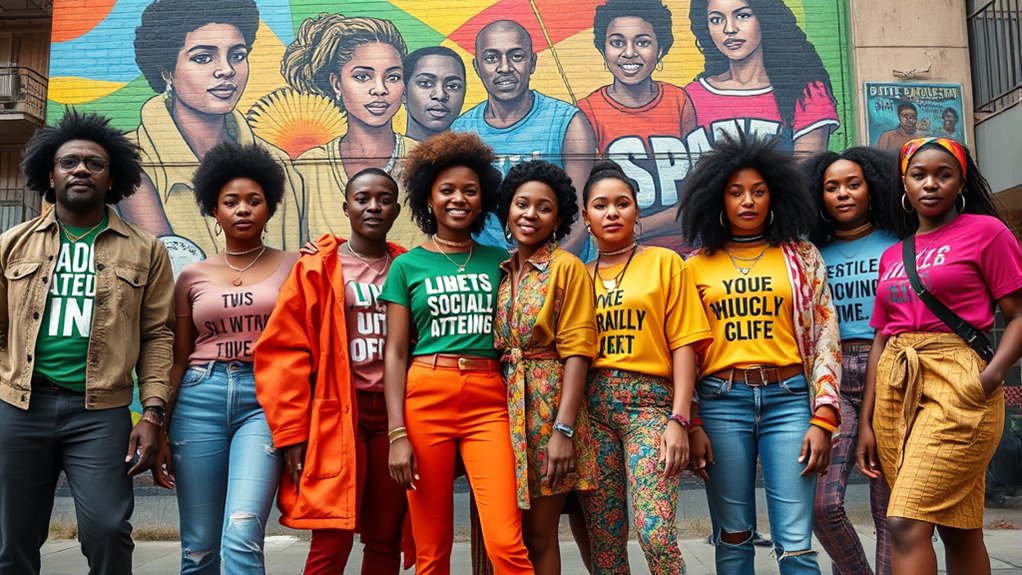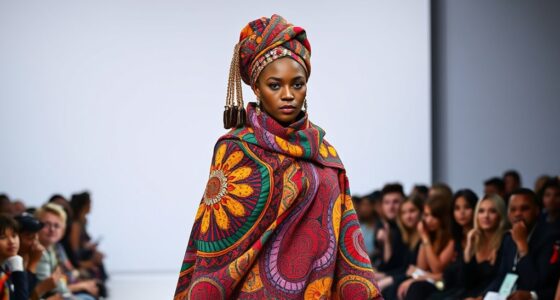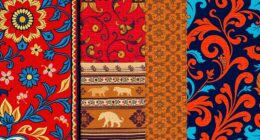Fashion activism transforms styles into powerful tools for social change, allowing you to express beliefs, challenge norms, and raise awareness through clothing. Celebrities, brands, and runway shows often spotlight critical issues—from equality to environmental justice—using symbolism, bold statements, and digital campaigns. Supporting ethical brands and sustainable practices amplifies your impact. If you want to discover how fashion continues to push boundaries for social progress, there’s much more to explore.
Key Takeaways
- Fashion activism uses clothing and runway statements to raise awareness and challenge social norms, turning style into a platform for change.
- Celebrities and brands amplify social messages through collaborations, endorsements, and culturally symbolic designs.
- Digital activism via social media enables rapid dissemination of social justice messages through fashion campaigns.
- Ethical and sustainable fashion choices promote social and environmental causes while addressing industry challenges.
- Future trends include innovative tech-driven activism and authentic representation, making style a catalyst for meaningful social progress.
The Evolution of Fashion as a Platform for Change
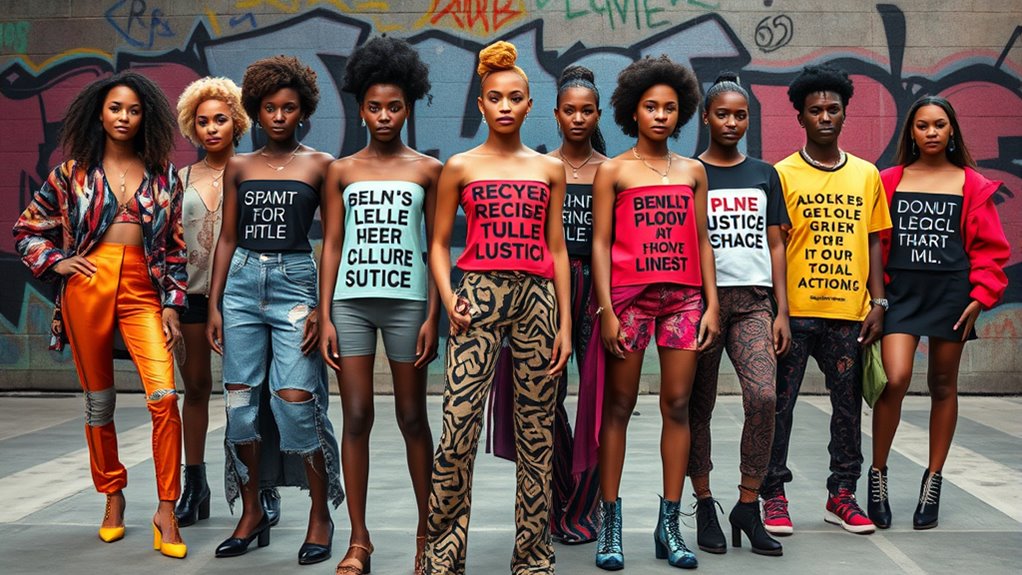
Fashion has long been a reflection of cultural values and social movements, but it’s also become a powerful tool for activism. Throughout fashion history, clothing has served as a form of expression and identity, often conveying messages beyond aesthetics. Style symbolism has allowed you to communicate your beliefs subtly or boldly, whether through color choices, designs, or accessories. Over time, designers and wearers have used fashion as a platform to challenge norms and raise awareness. From protest shirts to runway statements, you can see how fashion evolves alongside social change. This history demonstrates that clothing isn’t just about style—it’s a language that can inspire, unite, and push for progress. Understanding the role of ethical hacking in cybersecurity can also offer insights into how technology and activism intersect, empowering individuals and communities to protect their digital rights. Recognizing the influence of cultural transformation in fashion underscores how style can be a reflection of societal shifts and collective values, making your wardrobe a statement of activism rooted in decades of cultural transformation. Additionally, the adoption of size restrictions and sustainable building practices in various contexts shows how societal values influence personal expression and community standards, further highlighting the interconnectedness of social movements and individual choices.
Iconic Moments in Fashion Activism
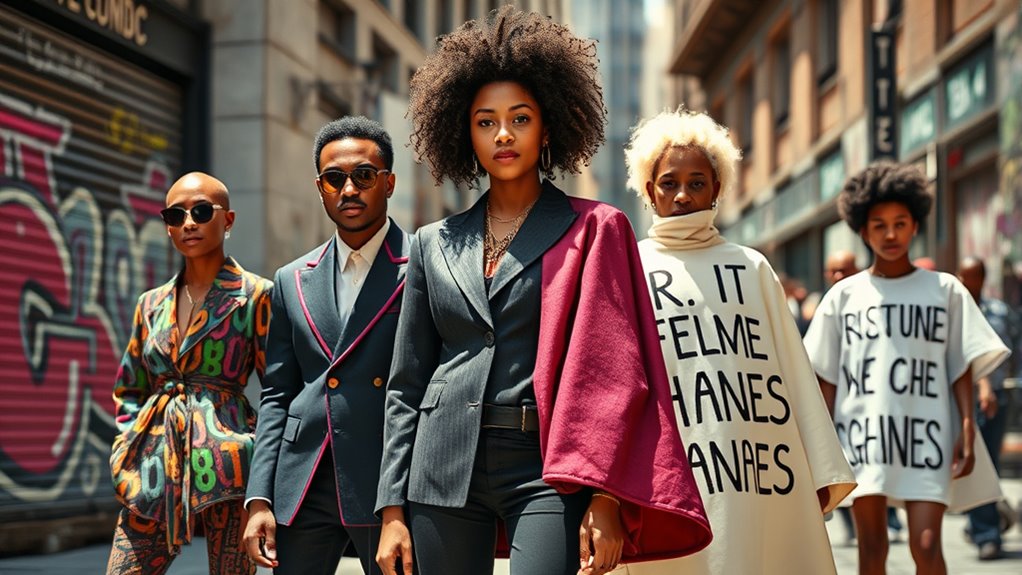
Throughout history, moments when clothing became a vessel for activism have left lasting impressions. You’ve probably seen how Vogue Collaborations have amplified social messages, turning fashion into a powerful platform for change. These collaborations often feature bold designs that challenge norms and spark conversations. Celebrity Endorsements also play a vital role, as influential figures use their visibility to highlight causes they care about. For example, when a celebrity wears a statement piece or partners with a brand committed to social justice, it sends a clear message. These iconic moments demonstrate how fashion can transcend aesthetics and become a rallying cry for activism. They remind you that what you wear can carry meaning and inspire collective action. Additionally, incorporating color symbolism into clothing choices can further emphasize social messages and evoke emotional responses. The strategic use of currency fluctuation awareness can also influence how brands position their social campaigns globally. As technology advances, the integration of AI in Education and other innovations continues to expand opportunities for awareness and engagement in social causes through fashion.
Brands Leading the Charge for Social Justice
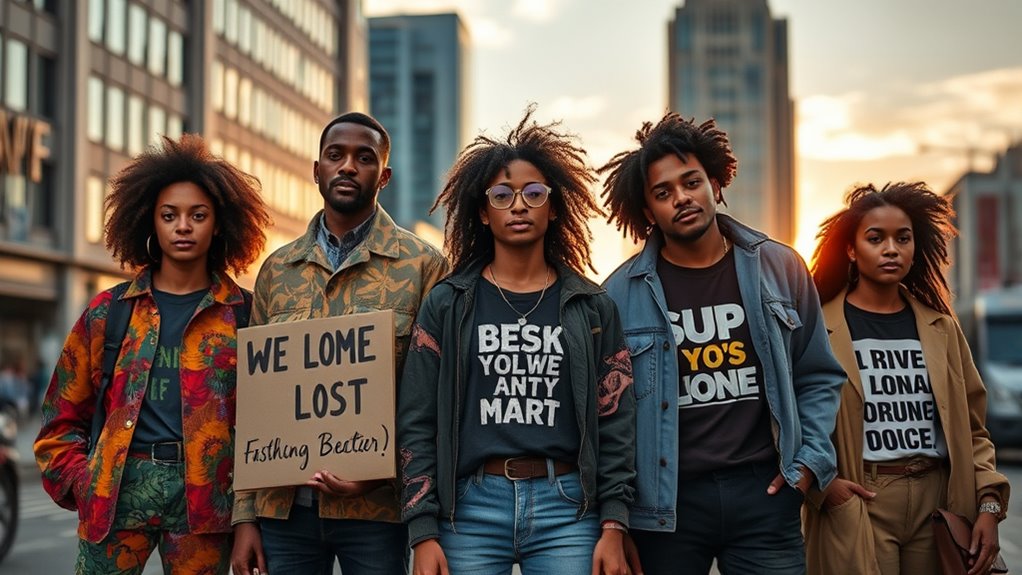
Have you noticed how some brands are actively shaping social justice conversations through their actions and messaging? Luxury branding now goes beyond aesthetics, using its influence to promote equality and inclusion. These brands leverage celebrity endorsements to amplify their stance, making social issues part of their identity. They sponsor campaigns, support marginalized communities, and speak out on urgent matters, turning their platforms into tools for change. Visualize this:
| Brand | Approach |
|---|---|
| High-end fashion label | Collaborates with activists, promotes diversity |
| Celebrity ambassador | Uses influence to champion social justice causes |
| Eco-conscious luxury brand | Funds community projects, advocates for environmental justice |
| Designer collaboration | Launches limited editions highlighting social issues |
These brands show that style and activism can coexist, inspiring others to follow suit. Additionally, many of these initiatives are rooted in cultural insights, emphasizing a deeper understanding of social dynamics. Recognizing the importance of cybersecurity in protecting brand messaging and digital campaigns is crucial as these efforts expand online.
Furthermore, leveraging generative AI can help brands craft authentic narratives that resonate with diverse audiences while safeguarding their reputation.
The Role of Runway Shows in Raising Awareness
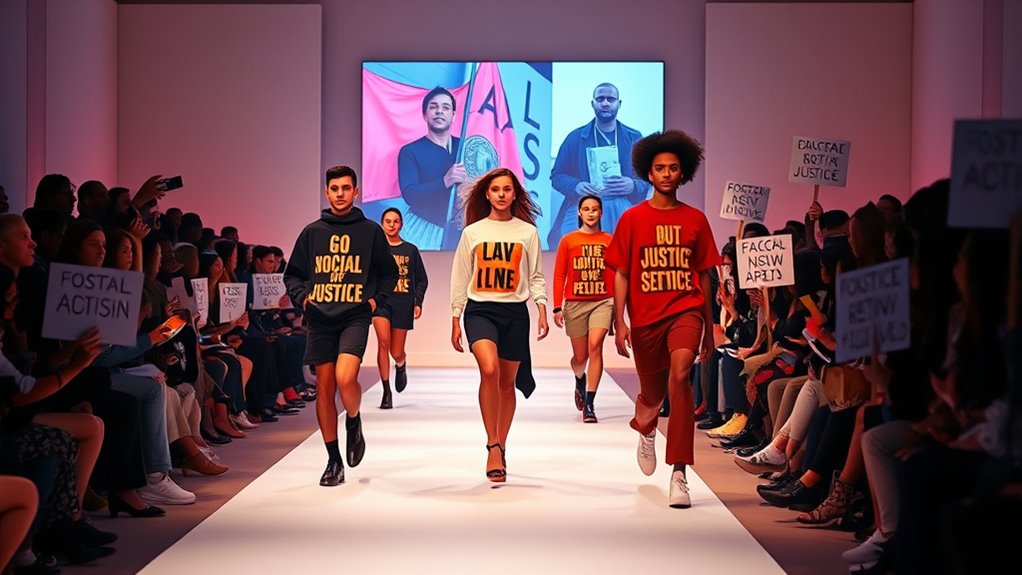
How can runway shows serve as powerful platforms for raising awareness about social issues? They leverage runway symbolism to communicate messages visually and emotionally. When designers showcase collections that highlight social causes, the runway becomes a stage for activism. Celebrity influence amplifies this effect, as high-profile figures draw media attention and public interest. By wearing activist-inspired designs or making statements during shows, celebrities lend credibility and urgency to social issues. This can spark conversations beyond the fashion world, inspiring fans and followers to engage. Incorporating cultural symbolism into runway presentation can further deepen the impact of social messages and foster meaningful engagement, especially when combined with ethical fashion practices that emphasize sustainability and social responsibility.
Sustainable Fashion and Environmental Advocacy
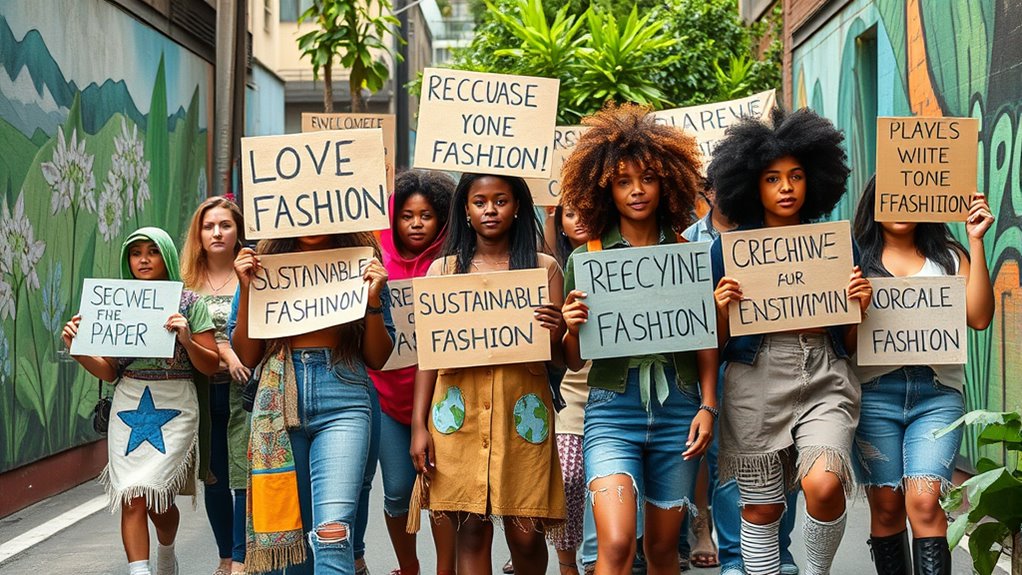
You can make a difference by choosing eco-friendly materials and supporting brands that prioritize ethical production practices. Every step to reduce fashion waste helps protect the environment and promotes responsible consumption. Additionally, adopting sustainable fashion practices can contribute to climate change mitigation efforts, as the industry’s environmental impact is increasingly scrutinized. Incorporating innovative wall organization techniques can also raise awareness about environmental issues through compelling audio storytelling. Together, these efforts turn fashion into a powerful tool for environmental advocacy.
Eco-Friendly Material Choices
Choosing eco-friendly materials is a powerful way to make your fashion choices more sustainable and reduce environmental impact. By selecting garments made from sustainable fibers and biodegradable textiles, you actively support eco-conscious practices. These materials break down naturally, minimizing waste and pollution. When shopping, look for:
- Clothing crafted from organic cotton, hemp, or Tencel
- Items made with biodegradable textiles that decompose safely
- Brands committed to using sustainable fibers and eco-friendly dyes
Opting for these materials helps conserve resources and reduces reliance on synthetic, non-biodegradable fabrics. Your choices can influence industry standards and promote more responsible manufacturing. Embracing eco-friendly material options demonstrates your dedication to environmental advocacy through style, making your wardrobe a statement of both fashion and activism.
Ethical Production Practices
Ethical production practices are essential for ensuring that fashion supports both people and the planet. When you prioritize fair labor, you’re advocating for workers to receive just wages, safe working conditions, and reasonable hours. Ethical sourcing means choosing materials and suppliers committed to sustainable and humane practices. By supporting brands that uphold these standards, you help reduce exploitation and environmental harm. You can look for certifications like Fair Trade or GOTS, which verify ethical sourcing and fair labor. Your choices influence the industry to adopt more responsible production methods. Every purchase becomes a statement against unethical practices, promoting transparency and accountability. Ethical production isn’t just about style; it’s about making a positive impact on the communities and ecosystems involved in creating your fashion. Incorporating sustainable supply chains into your shopping choices further reinforces responsible practices within the industry. Emphasizing ethical manufacturing practices encourages brands to improve working conditions and reduce environmental footprints across their entire supply network, which can also involve adopting sound healing science principles to promote well-being in manufacturing environments.
Reducing Fashion Waste
Building on the importance of ethical sourcing and fair labor practices, reducing fashion waste offers a powerful way to minimize environmental impact. You can embrace recycling initiatives by repurposing old garments or donating unused items, extending their life and reducing landfill waste. Zero waste designs focus on creating garments with minimal fabric scraps, cutting down on waste during production. Consider supporting brands committed to sustainable practices, which prioritize eco-friendly materials and transparent supply chains. Additionally, adopting circular fashion principles encourages reusing, recycling, and restoring clothing instead of discarding it. Implementing sustainable fashion practices can significantly lower pollution, conserve resources, and promote a more responsible fashion industry. Your choices contribute directly to environmental advocacy and foster a culture of sustainability in style. Incorporating waste reduction strategies into your wardrobe decisions can further amplify your positive impact on the planet.
How Consumers Can Support Ethical Fashion Movements
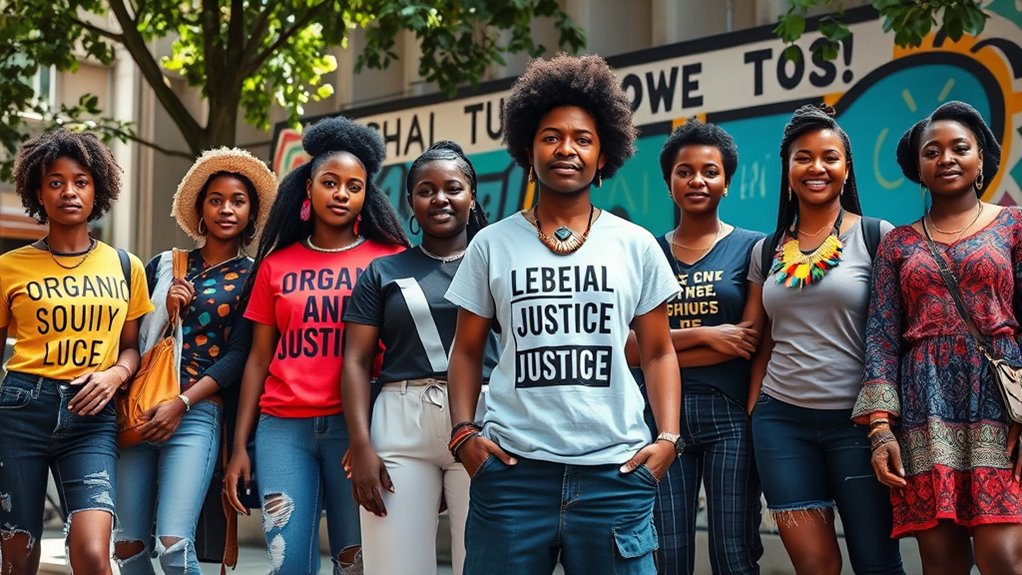
To support ethical fashion movements, you can start by educating yourself about brands that prioritize fair labor practices and sustainable materials. Ethical shopping involves choosing companies committed to transparency and social responsibility. Look for certifications like Fair Trade or B Corp to verify claims. Participating in advocacy campaigns allows you to raise awareness and influence industry standards. Share information on social media, attend events, or support petitions advocating for better labor conditions. Your consumer choices directly impact brands’ priorities and encourage ethical practices. Additionally, buying secondhand or vintage reduces demand for fast fashion and promotes sustainability. Being aware of popular anime movies and animated films that touch hearts can inspire more compassionate and culturally aware consumer choices. Engaging with creative practice can also foster a deeper understanding of the importance of ethical standards in production. Incorporating ethical fashion into your wardrobe not only supports responsible brands but also promotes a shift towards more sustainable industry practices. Every purchase and advocacy effort helps shift the industry toward more ethical and environmentally friendly standards. Your active involvement makes a real difference in supporting ethical fashion movements.
Challenges and Criticisms of Fashion Activism

You might notice that fashion activism faces criticism for becoming too commercialized, risking its original message. Authenticity can be hard to maintain when brands prioritize profit over purpose, and cultural appropriation can lead to misunderstandings or offense. These challenges make it clear that staying true to activism’s core values is essential to avoid undermining its impact.
Commercialization Concerns
While fashion activism aims to promote social change, its commercialization often raises concerns about authenticity and motives. When luxury branding and celebrity endorsements become the norm, it can feel like activism is being co-opted for profit. You might question whether brands genuinely support causes or simply capitalize on trending issues for sales. The use of high-profile figures can blur the line between advocacy and marketing, making activism seem superficial.
Consider these points:
- Luxury brands leveraging activism for brand elevation without meaningful change
- Celebrity endorsements overshadowing grassroots voices and local initiatives
- The risk of activism becoming a marketing tool rather than a genuine movement
This commercialization can dilute the message, turning social issues into commodities rather than catalysts for real change.
Authenticity Challenges
Is fashion activism truly driven by genuine concern, or is it often just a carefully crafted image? Many brands adopt a veneer of authenticity by emphasizing vintage authenticity, claiming their styles support history and tradition. However, skepticism arises when these efforts seem superficial or profit-driven. You may wonder if their activism is sincere or a marketing ploy to boost sales and reputation. Brand transparency becomes critical here—if companies aren’t open about their supply chains, sourcing, or motivations, their activism loses credibility. Authenticity challenges surface when you question whether these initiatives are about meaningful change or simply surface-level gestures. Ultimately, you must look beyond the surface, scrutinizing whether brands truly align their practices with their activism or just craft a compelling image to appeal to socially conscious consumers.
Cultural Appropriation Risks
Fashion activism often aims to promote cultural awareness and support marginalized communities, but it can also unintentionally cross into cultural appropriation. When you adopt elements from another culture without proper understanding or respect, you risk undermining cultural sensitivity and authentic diversity representation. This can lead to criticism, alienating the communities you’re trying to uplift. To navigate these challenges, consider:
- Engaging with community members to ensure respectful representation
- Educating yourself on the cultural significance behind symbols and styles
- Amplifying voices from marginalized groups rather than speaking for them
The Future of Style as a Tool for Social Transformation
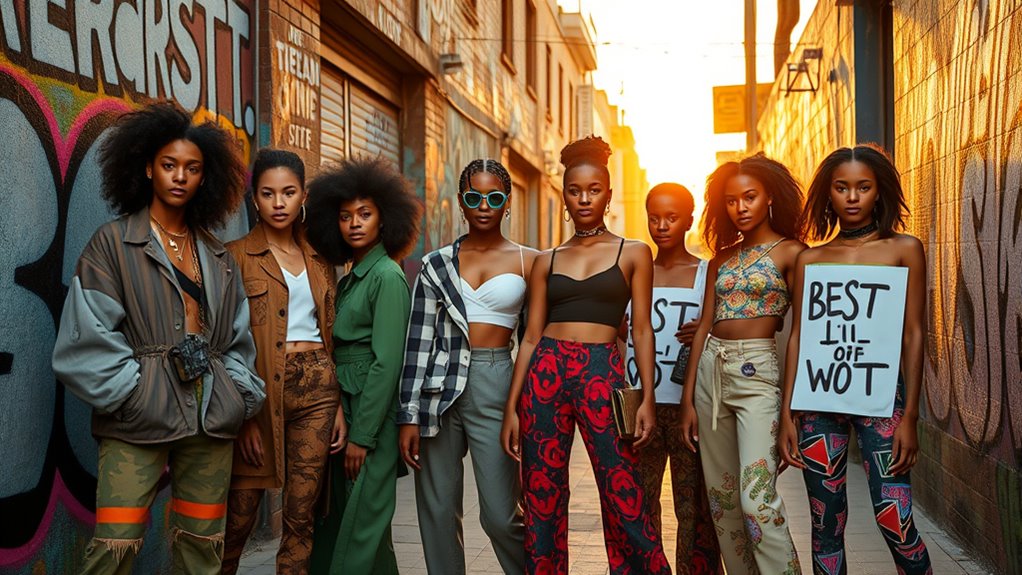
The future of style as a tool for social transformation is bright, with designers and consumers increasingly leveraging fashion to challenge norms and promote change. Digital activism plays a pivotal role, allowing you to spread messages quickly and rally support for causes through social media campaigns and virtual events. Fashion philanthropy is also gaining momentum, as brands and individuals donate proceeds or create collections that highlight social issues. You can participate by choosing brands committed to ethical practices or supporting initiatives that use fashion to address inequality and environmental concerns. As technology advances, expect more innovative ways to combine style with activism, making it easier for you to wear your values and push for social progress. Your fashion choices can truly become catalysts for meaningful change.
Frequently Asked Questions
How Do Fashion Activists Measure the Impact of Their Campaigns?
When you want to measure the impact of your campaigns, you look at consumer engagement and campaign metrics. You track social media interactions, website traffic, and sales figures to see how many people your message reaches and influences. By analyzing this data, you can determine if your efforts are raising awareness or prompting action, helping you refine your strategies for greater social impact through fashion activism.
What Are the Risks Faced by Celebrities Involved in Fashion Activism?
Ever wondered what risks you face as a celebrity involved in fashion activism? You could encounter celebrity backlash if your stance divides fans or critics, risking your public image. Your brand reputation might suffer if your activism clashes with sponsors’ values or commercial interests. Are you prepared for the possibility that your social efforts could backfire, leading to negative publicity or loss of endorsements? Activism demands courage, but it also comes with tangible risks.
How Can Small Brands Effectively Participate in Social Justice Efforts?
You can effectively participate in social justice efforts by prioritizing sustainable sourcing and forming community collaborations. Focus on transparent supply chains to show your commitment to ethical practices. Partner with local organizations to support causes that matter. Use your platform to raise awareness and amplify marginalized voices. By taking these steps, you demonstrate genuine engagement and create meaningful change, even as a small brand. Your actions can inspire others and foster a more just fashion industry.
What Legal Challenges Do Activist Fashion Campaigns Sometimes Encounter?
When you’re pushing for social change through fashion, legal challenges can feel like storms on the horizon. You might face copyright disputes over designs or defamation lawsuits if your campaign hits sensitive nerves. These hurdles test your resilience and commitment. Staying informed about intellectual property laws and consulting legal experts can help you navigate these challenges. Remember, standing up for causes often involves weathering legal storms to make a meaningful impact.
How Does Fashion Activism Influence Mainstream Consumer Behavior?
You see, fashion activism influences mainstream consumer behavior by highlighting issues through powerful messaging. When celebrities endorse sustainable materials, it grabs your attention and encourages you to make eco-friendly choices. This shift in perception makes sustainable fashion more appealing, prompting you to support brands that align with social change. Your purchasing decisions become a form of activism, amplifying the movement and inspiring broader societal change.
Conclusion
As you explore the world of fashion activism, remember that your choices can gently steer change. By embracing ethical brands and thoughtful styles, you become part of a movement that softly reshapes society. Your voice, expressed through what you wear, can subtly influence hearts and minds. Keep in mind, every small step adds to a larger, hopeful shift—where style and purpose blend seamlessly, inviting a brighter, more compassionate future for all.
